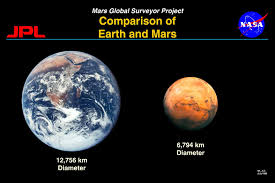Overview
The planet Mars is the fourth planet from the Sun, and the last of the terrestrial planets in the Solar System. It is almost 228,000,000 km from the Sun, about 1 ½ times the distance of the earth from the Sun. It has a thin atmosphere, and is mostly desert, with volcanoes, ice caps, and frozen water. At this point, missions to Mars have been either flybys or unmanned rovers, and new discoveries about the planet are made almost every day. Scientists plan to send astronauts to Mars in the 2030s.
Early Observations of Mars
The reddish color and wandering nature of the planet Mars were known to Egyptian astronomers, ancient Greeks, and Babylonians. Chinese astronomers called it “the fire star”, and astronomers in India estimated its size. Galileo examined it with his telescope in 1610, but it is so far away that many features were not discernible. In the late 1800s, astronomers with more powerful telescopes, including the Lowell Observatory, drew detailed maps of the planet, and speculated about its features. Two moons were discovered and named Phobos and Deimos. The rotation of Mars produces a day that is about 24 ½ hours long; a Martian year is over 680 days long, and it appears to have “seasons” because its orbit is eccentric.
Structure and Composition of Mars
Mars has an iron-nickel core surrounded by a silicate mantle and a relatively thick crust. It has many volcanoes, including one of the tallest mountains in the entire solar system, Olympus Mons, nearly 25 km (16 mi) high, about three times as tall as Mt. Everest. There are also impact craters scattered all over the surface, with highlands, canyons, and lava flows. Although liquid water doesn’t exist anywhere on the surface of Mars currently, there is evidence that it may have existed at one time, the polar ice caps are made of frozen water and dry ice, and there may be briny water underneath the surface soil, according to the most recent observations in 2014 and 2015 by the space rover Curiosity.
The History of Martian Space Exploration
There have been a number of unmanned spaceflights that have either flown by Mars, orbited the planet, or landed on the planet itself. In the 1960s and 1970s, Soviet craft crash-landed on Mars. NASA’s Mariner program successfully orbited the red planet, and sent back pictures that helped clear up some of the many mysteries. Currently, there are a number of spacecraft orbiting Mars, as well as two rovers, Opportunity and Curiosity. The constant stream of telemetry is sent to scientists back on Earth. Curiosity has a laboratory to drill soil and analyze samples, monitor the weather, and measure radiation.
Future Exploration of Mars
Currently, several unmanned flights are planned, by the US, Russia, India, China, and the European Union. Some of the plans include bringing samples of Martian soil to earth in the 2020’s. There are also proposals to send manned missions to Mars in 2030 and beyond, including a human mission to send colonists to live on the planet.
Interested in science tutoring services? Learn more about how we are assisting thousands of students each academic year.
SchoolTutoring Academy is the premier educational services company for K-12 and college students. We offer tutoring programs for students in K-12, AP classes, and college. To learn more about how we help parents and students in Clinton, MO: visit Tutoring in Clinton, MO




